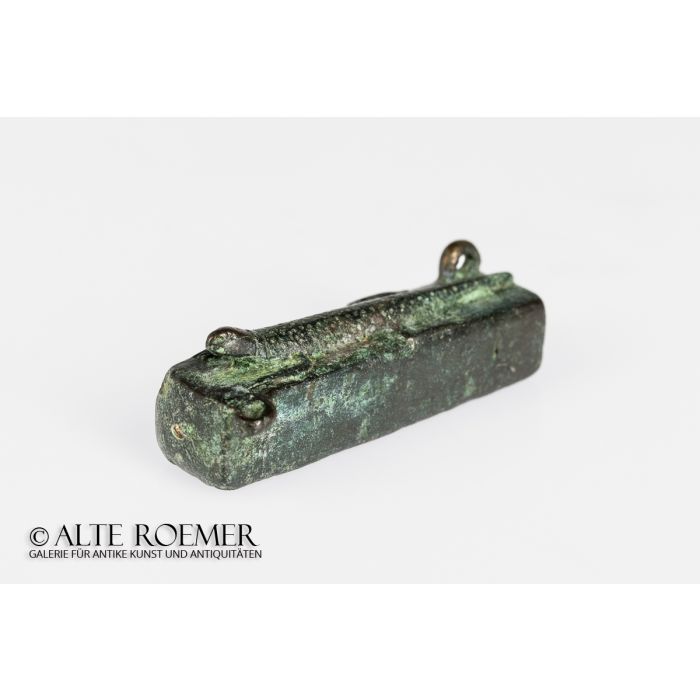Egyptian coffin with lizard
Price: on request
Sold
Object number
AR2499-03
| Object: |
Egyptian coffin for a lizard
|
| Material: |
Bronze.
|
| Period: |
Late Period to Ptolemaic rule of Ancient Egypt. 664 BC to 30 BC. |
| Description: |
Egyptian bronze coffin for a lizard. Rectangular long box with two loops at the upper rim. Adorned with a lizard figure on top slightly raising its head.
|
| Background: |
This type of box is also called animal relic box or mummy case. And indeed it's primary purpose was to hold animal remains. Animal worship became massively popular in the 1st millennium BC in Egypt. Millions of animals have been mummified and burried from the Late Period to Ptolemaic rule. Small bronze coffins like the piece described above had a opening at the rear side to insert an animal mummy or part of it. The animal shown on the coffin indicates what the box is to contain. In rare cases an inscription was found on the side of the box that states it was devoted to a god. For lizard coffins that was typically the god Atum. Boxes from 19th and 20th century excavations have often been opened and emptied. Some never contained animal remains. It is possible that unethical dealers in votive objects scammed their ancient Egyptian customers and sold boxes filled with other materials like stones. It is only since the 21st century that curators and researchers display a strong interest in the contents of such coffins. In 2019 the British Museum x-rayed 8 small relic boxes with intact original seals. Only 3 contained bones with certainty, the contents of the other 5 boxes could not be clearly identified. Some puzzles remain unsolved. |
| Dimensions: |
67mm length, 19mm width (without loop), 22mm height.
|
| Condition: |
Great condition. Only one foot part missing. Nice patina.
|
| Provenance: |
Acquired by us in a German auction house in 2018. Consigned by the heir of a German private collection. Acquired for the collection in May 1980 from the stock of the "Aegyptiaca" society in Switzerland. Selected and brokered by Hermann Schlögl (Freiburg i. Br.). The Aegyptiaca society sold this object from the famous Matouk collection which was in storage at the archaeological collection of Zürich university. It was brought there in 1976, exported from Lebanon, with no Lebanese laws prohibiting the export. Fouad S. Matouk formed his collection between 1925 and 1976. It was located in Egypt until 1960 and in Lebanon afterwards. About the famous Matouk collection: The collection of Fouad Sélim Matouk (1902-1978) included 8520 ancient Egyptian seals, amulets and bronzes, as well as some pieces dating to Greco-Roman and Coptic times. The collection held 6800 scarabs, the third biggest amount worldwide after the Egyptian Museum in Cairo and the British Museum in London. Being Christian Arabs Matouk's parents with his son fled their country of birth Syria and settled in Egypt at the beginning of the 20th century. It was there young Matouk started to build his collection in the mid 1920ies. A prominent part was acquired by him in 1956 in Cairo. It came from the also famous collection of the antiquities dealer Ralph Harrup Blanchard (1875-1936). As a whole the Matouk collection was based on a scientific point of view concerning the typological evolution of form and decoration. In the year 1960 the collector and trader had to leave Egypt under Nassar's rule and flea to Lebanon. After the Lebanese civil war started Matouk brought his collection to safety in Switzerland in 1976. That is how it could be protected from the chaos of the war, except for the ancient glasses which fell prey to the war. Shortly afterwards financial pressure made Matouk decide to sell his collection. He wanted the archaeological institute of Zürich university to have it. But after his unexpected death in 1978 in Beirut his son Tawfik Fouad Matouk had to continue this endeveaor. Zürich university could not pay the full price. The resulting idea was the foundation of the "Aegyptiaca" society with the financial aid of the Swiss Federation. The society should sell part of the Matouk collection to private collectors until the revenue was enough to buy the remaining part of the collection for Zürich University. Before that the objects were properly researched by the renowned archeologists Prof. Dr. Eric Hornung, Prof. Dr. Othmar Keel, Dr. Leo Mildenberg, Dr. Hermann Schlögl and Dr. Michael Sguaitamatti. In the end the largest part of the objects were added to the stock of Fribourg University. There, Othmar Keel worked with the pieces, in his function as a Professor for Old Testament and Biblical Environment. From the part sold to collectors initially a significant amount of objects could be acquired by Alte Roemer Gallery in 2018 and 2019. We are extremely happy to be able to work with those important pieces ourselves. The younger history including names like Matouk and Blanchard is proudly standing up to the Old Egyptian history of those little works of art. |
| References: |
Cf. Petrie, Amulets, plate XIII, no. 101a.
|
| Literature: |
An analysis of Egyptian votive coffins has been made by A. Masson-Berghoff, D. O'Flynn in "Absent, invisible or revealed ‘relics’? X-radiography and CT scanning of Egyptian bronze votive boxes from Naukratis and elsewhere", British Museum Studies in Ancient Egypt and Sudan 24 (2019), p. 159–174.
|
| Authenticity: |
We unconditionally guarantee the authenticity of every artefact, all items are subject to our lifetime return policy on authenticity.
|


